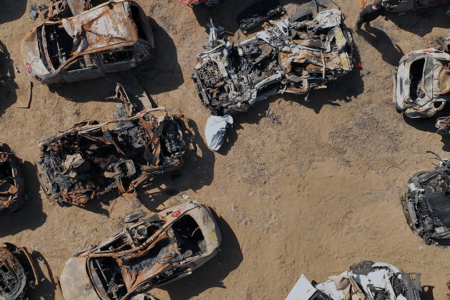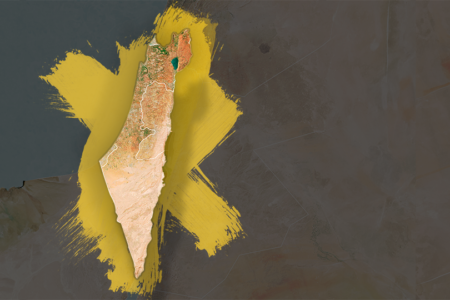The Brazen Altar: Christ Our Justification
Exodus 27:1-8; Romans 4:24, 25
The tabernacle stood in all its pristine glory with the twelve tribes camped around it. How inspiring it must have seemed to the Israelites as they gazed upon its colorful gates and beautifully sculptured furnishings of gold, silver and brass glistening in the sunlight. From their tents each one could see the visible presence of God’s glory hovering over it, in the form of a cloud by day and a pillar of fire by night, assuring them of His guiding presence. Come, let us enter the court and witness what is involved in the ministry at the brazen altar.
The Structure Of The Altar And Its Significance
Slowly the Israelite would reverently approach the tabernacle, draw back the curtain, and enter its court to present his sacrifice. Upon entering the court he would stand in awe gazing at the blood-stained altar as the smoke from previous sacrifices curled into the sky. The altar was a very simple hollow box (v. 8), made of shittim (i.e. acacia) wood, overlaid with brass, 7½ feet square, standing 4½ feet high, possessing four horns pointing outward at each corner (vv. 1, 2). A brass grate extended through its middle in which brass rings were fastened at each corner (vv. 4, 5); wooden staves covered with brass were put through the rings for the purpose of carrying the altar (vv. 6, 7). The construction of the altar was not of Moses’ creation; God had revealed it to him on the mount (v. 8). There it stood just inside the court gate (Ex. 40:6), facing the tabernacle, the largest piece of furniture used in worship and always open to the guilty Israelite so he could atone for sin.
For the Christian the altar is full of symbolic meaning and spiritual teaching. The shittim (acacia) wood was a hard, incorruptible and indestructible wood which grows in the Sinai desert. It beautifully portrays the humanity of Christ who came from a “root out of a dry ground” (Isa. 53:2), and was sinless in His human nature (Heb. 4:15; 7:26). The indestructibility of the wood speaks of Christ in His humanity: withstanding the fire of crucifixion (Jn.10:18); the decaying effect of the grave (Acts 2:31); and His body which was victoriously resurrected (Mt. 28:5, 6).
The brass covering over the shittim wood typifies the divine righteousness and judgment of Christ. Christ, the righteous One (1 Jn. 3:5), took the divine judgment of God upon Himself, bearing our judgment on the cross by becoming sin for us (2 Cor. 5:21). As all were saved from death when they looked upon the brass serpent which Moses held up in the wilderness, so shall all who trust in Jesus Christ, who was lifted upon the cross as a sacrifice for sin, be saved from damnation (Jn. 3:14, 15). Finally, Christ’s appearance to John on the Isle of Patmos with feet of “fine bronze as if they burned in a furnace” (Rev. 1:15) speaks of His judicial character in judging His enemies at the Second Coming.
The four horns on each corner of the altar spoke of power (cf 1 Sam. 2:1-10; 2 Sam. 22:3) and were used in binding the sacrifice to the altar (Ps. 118:27). They were also sprinkled with the blood of the sacrifice (Ex. 29:12). The sacrifice tied to the horns points to Christ’s unfaltering commitment to carry out the Father’s will (Heb. 10:5-7) when He was willing to be nailed to the cross as our blood atonement (Mt. 26:39, 42). His shed blood on the cross expiates the sins of all those willing to put faith in His sacrificial death for them (Rom. 3:25, 26). The blood-stained horns pointed upward and outward to the four areas of the world reminding us of the saving power of Christ’s blood which will be witnessed throughout the world (Acts 1:8).
The Sacrifice At The Altar And Its Significance
The purpose of the brazen altar was for sacrifice. Without sacrifice there could be no atonement for sin (Lev. 17:11; Heb. 9:22). Soberly, the Israelite would bring the prescribed offering without spot or blemish to the priest who stood at the tabernacle’s gate to receive it. The offerer laid his hands on the head of the offering symbolic of his identification with its substitutionary death on his behalf – his sins were transferred to the sacrifice and the life of the sacrifice to him. The offerer then killed the animal while the priest caught the sacrificial blood in a basin to be offered as an atonement. The priest, functioning as a mediator, sprinkled the blood of the sacrifice on the altar and poured the remaining blood in the basin at the altar’s base. Then the priest would cut the sacrifice into pieces, the inner parts were washed, and various pieces were burned upon the altar as a sweet savor unto the Lord.
It was at the altar that an innocent lamb would bear the judgment of the guilty. Christ our Lamb (Jn. 1:29; Rev. 13:8) died upon the altar of the cross to bear the judgment of God’s wrath against sin on our behalf (Isa. 53:3-6; Rom. 4:25). The sacrifice being burnt upon the altar as a sweet savor to God (Lev. 1:9) typifies Christ who was offered up as a “. . . sacrifice to God for a sweet-smelling savor” (Eph. 5:2).
The word “altar” means “high place”. The sacrifice had to be lifted upon the elevated altar (Lev. 9:22). Christ being lifted upon the cross as our sacrifice speaks of this, “And, as Moses lifted up the serpent in the wilderness, even so must the Son of man be lifted up” (Jn. 3:14).
The fire on the altar continually burned having a twofold meaning. It proclaimed God’s holiness and justice, and it was symbolic of His readiness to receive man’s sacrificial offering to cleanse from sin.
The Serving Utensils At The Altar And Their Significance
The five utensils used to serve the altar are typified in Christ. Pans and shovels received the precious ashes of the sacrifice and the ashes were carried outside the camp to be disposed of in a clean place. The ashes speak of the finished work of Christ (Jn. 19:30), and being put into a clean place typifies His burial in a new sepulcher (Jn. 19:41). The basin received the blood of the sacrifice and was poured out at the base of the altar typifying Christ who poured out His blood on our behalf (Heb. 9:12-15). Flesh hooks represent the cruel hands of men who nailed Him to the cross (Lk. 23:33). Fire pans (i.e. censers), which carried the fire from the brazen altar to the altar of incense, represent Christ’s intercessory ministry of prayer at the Father’s throne (Heb. 7:15) as our Advocate (1 Jn. 2:1).
The Salvation Which The Altar Symbolized
Both the brazen altar and the cross of Christ speak of justification. To be justified does not mean we are “made righteous”, but that we have been “declared righteous” – put into a right relationship with God (Rom. 4:24). Thus, justification is a judicial act of God, whereby He declares us righteous, when we put trust in Jesus Christ’s work on the cross on our behalf. In the days of the tabernacle, an Israelite was restored to a right relationship with God by offering a blood atonement on the altar; today, Jew or Gentile is restored by appropriation of the atoning blood of Christ to take away his sin. Justification is not by any work we do, but is bestowed freely through the grace of God (Rom. 4:24), resulting in the removal of the guilt and punishment of sin, imputing the righteousness of Christ to our life and restoring us to favor and fellowship with God (Rom. 4:25).
The position of the altar spoke of access and fellowship with God. It stood inside the court facing the door of the tabernacle. Before the priest could pass to the tabernacle it was mandatory for him to offer a blood sacrifice on the brazen altar. Today, access and fellowship with God can only come through the sacrificial death of Christ (1 Tim. 2:5; Heb. 9:15).
To approach the tabernacle of God without offering a proper sacrifice on the altar meant certain death. If we reject the meritorious sacrifice of Christ’s work on the cross, it means separation from God and eternal death (Jn. 3:36; 1 Jn. 5:12).
There is another sacrifice which God requires for the believer. One is to present himself as a “living sacrifice” to God (Rom. 12:1). The words of Paul sum up our consecration so well when he writes:
I am crucified with Christ: nevertheless I live; yet not I, but Christ liveth in me; and the life which I now live in the flesh I live by the faith of the Son of God, who loved me and gave himself for me (Gal. 2:20).
Have you committed your life as a “living sacrifice” to God? Without allowing Christ to control the altar of your life, you will not be able to manifest a fruitful walk in service for Him. Why not draw back the curtain of your life, and offer it on the altar of sacrifice for God’s service? As believer-priest, we must be continually cleansed from sin before we can enter into God’s service. In our next article we will approach the brazen laver and see what is involved in our cleansing for spiritual service.







